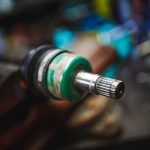1. Introduction to Wind Tunnel Testing
When you hear about high-performance cars or fuel-efficient vehicles, you might not realize that a lot of their success comes from something called wind tunnel testing. This is a process automakers use to make sure their cars are as aerodynamic as possible. But what exactly is wind tunnel testing, and why does it matter so much in the automotive world?
What Is Wind Tunnel Testing?
Wind tunnel testing is a method used by car manufacturers to study how air flows around a vehicle. In simple terms, they place a car—sometimes a full-size model, sometimes a smaller scale version—inside a large tunnel where air is blown at high speeds. By doing this, engineers can see how the car interacts with the air and figure out ways to reduce drag, which is the force that slows a car down as it moves through the air.
Why Aerodynamics Matter
Aerodynamics isn’t just for racecars. Every vehicle on the road faces air resistance. The more streamlined a car’s shape, the less energy it takes to move forward. That means better gas mileage for everyday drivers, higher top speeds for sports cars, and even quieter rides because wind noise gets reduced.
Main Benefits of Wind Tunnel Testing
| Benefit | Impact on Vehicles |
|---|---|
| Improved Fuel Efficiency | Less drag means engines don’t have to work as hard, saving fuel. |
| Enhanced Performance | Sleeker shapes allow for faster acceleration and higher speeds. |
| Better Stability | Reduces lift and helps keep the car steady at highway speeds. |
| Lower Noise Levels | Smoother airflow leads to a quieter cabin experience. |
The Big Picture in the U.S. Automotive Industry
In America, where long commutes and road trips are common, optimizing aerodynamics isn’t just about speed—it’s about getting more miles per gallon and making driving more enjoyable. From pickup trucks in Texas to electric cars in California, wind tunnel testing helps automakers design vehicles that fit American lifestyles while meeting strict efficiency standards.
2. The Science Behind Aerodynamics
When it comes to designing modern vehicles, understanding aerodynamics is crucial for automakers. Aerodynamics is the study of how air moves around objects—in this case, cars and trucks. How a vehicle interacts with the air directly affects its performance, fuel efficiency, and even how much noise you hear on the highway.
How Airflow Impacts Vehicle Performance
When a car moves forward, it pushes against the air in front of it. This creates a force called drag, which tries to slow the vehicle down. The more streamlined a car’s shape, the less drag it produces, allowing it to cut through the air more smoothly. Automakers use wind tunnel testing to study and reduce this drag as much as possible.
Main Aerodynamic Forces
| Force | Description | Impact on Driving |
|---|---|---|
| Drag | The resistance caused by air as the vehicle moves forward | Reduces speed and fuel efficiency if not minimized |
| Lift | The upward force that can make a car feel lighter at high speeds | Makes handling unstable if not controlled, especially at highway speeds |
| Downforce | The downward push that keeps tires planted on the road | Improves traction and cornering ability for better control |
Aerodynamics and Fuel Efficiency
One of the main reasons automakers focus on aerodynamics is to boost fuel efficiency. When a vehicle has less drag, its engine doesn’t have to work as hard to keep it moving. This means it uses less gas or electricity per mile. Even small design changes—like smoothing out side mirrors or lowering a car’s stance—can make a noticeable difference in miles per gallon (MPG).
Aerodynamic Features That Matter Most
| Feature | How It Helps |
|---|---|
| Sleek Body Shape | Lets air flow smoothly around the vehicle, reducing drag and noise |
| Spoilers & Air Dams | Direct airflow to increase downforce and minimize lift at higher speeds |
| Covered Undercarriage | Keeps airflow smooth underneath the car for better stability and MPG |
| Tapered Rear End (Boat-Tail) | Cuts off turbulent air at the back, which reduces drag significantly |
Everyday Examples of Aerodynamics in Action
If you’ve ever noticed why sports cars look so low and sleek, or why pickup trucks are starting to get smoother front ends and tailgates, that’s aerodynamics at work. Automakers test these shapes in wind tunnels to find out what works best for both performance and efficiency. Whether you’re driving a family SUV or a high-performance EV, smart aerodynamic design helps your ride go farther on every tank—or charge—of energy.

3. How Wind Tunnel Testing Is Conducted
The Basics of Wind Tunnel Testing
Wind tunnel testing is a key step in helping automakers design cars that cut through the air efficiently. This process simulates how air flows over a vehicle, allowing engineers to find ways to reduce drag and improve fuel efficiency. Lets break down how this testing works, what equipment is used, and what really goes on inside a wind tunnel.
Step-by-Step: The Wind Tunnel Testing Process
| Step | Description |
|---|---|
| 1. Preparing the Vehicle | The car or model is carefully cleaned and fitted with sensors to measure airflow and pressure. Sometimes, clay models or prototype vehicles are used instead of production cars. |
| 2. Placing the Vehicle | The vehicle is positioned on a platform inside the wind tunnel, usually held in place by struts or mounts that dont interfere with airflow measurements. |
| 3. Starting the Airflow | Powerful fans push air through the tunnel at controlled speeds to mimic real driving conditions—anything from city cruising to highway speeds. |
| 4. Data Collection | Sensors and cameras capture data on how air moves around the car, where turbulence forms, and which areas create drag. |
| 5. Analyzing Results | Engineers review the information to spot areas for improvement. They may tweak designs, then test again to see if changes make a difference. |
Main Equipment Used in Wind Tunnel Testing
- Wind Tunnel: A large tube or chamber with powerful fans that generate controlled airflow.
- Turntable: Allows engineers to rotate the car for testing at different angles.
- Sensors: Devices that measure pressure, force, temperature, and velocity at various points on the cars surface.
- Smoke or Dye Injection: Makes airflow visible so engineers can see patterns and turbulence.
- Cameras: High-speed cameras record airflow behavior and help spot problem areas quickly.
What Happens Inside a Wind Tunnel?
Inside the wind tunnel, its all about creating repeatable conditions that mimic real-world driving but without unpredictable weather or traffic. Engineers can change wind speed, direction, and even simulate rain or road conditions. As air rushes over the vehicle, computers gather thousands of data points every second. By analyzing these results, automakers can fine-tune every detail—from side mirrors to spoilers—to squeeze out better fuel economy and stability on American highways.
4. Real-World Applications: From Prototypes to Production
After automakers collect data from wind tunnel testing, the real magic happens—they turn that information into practical design choices for everyday vehicles. Wind tunnel results aren’t just numbers and graphs; they directly shape what you see on the road, from sleek sedans to tough SUVs.
How Wind Tunnel Data Influences Vehicle Design
Engineers use wind tunnel findings to tweak everything from a car’s side mirrors to its underbody panels. These tests help identify where air resistance is highest and where improvements can make the biggest impact. By making changes based on this data, automakers can lower drag, boost fuel efficiency, and even reduce wind noise inside the cabin.
Examples of Wind Tunnel-Inspired Design Choices
| Design Element | Wind Tunnel Impact | Result in Mass-Market Cars |
|---|---|---|
| Spoilers & Air Dams | Tested for optimal angle and size to manage airflow | Better stability at highway speeds, sportier look |
| Side Mirrors | Shaped to minimize drag and wind noise | Quieter ride, improved fuel economy |
| Wheel Covers & Underbody Panels | Streamlined to smooth out turbulent air | Smoother ride, higher gas mileage |
| Grille Shutters | Tuned for automatic opening/closing based on cooling needs | Improved aerodynamics without sacrificing engine cooling |
| C-Pillar Design (rear roof area) | Refined to prevent air separation and reduce vortexes | Less drag, more attractive rear styling |
The Journey from Prototype to Showroom Floor
Once a prototype performs well in the wind tunnel, the next step is often computer simulations and real-world road tests. But it’s those initial wind tunnel sessions that set the tone for the whole development process. The end goal? To deliver cars that not only look good but also save drivers money at the pump and provide a more comfortable ride.
5. Cutting-Edge Technologies in Wind Tunnel Testing
Modern wind tunnel testing is no longer just about putting a clay model or prototype car into a tunnel and measuring airflow. Automakers now use advanced technologies to get the most accurate results while saving time and money. Let’s take a look at some of the latest innovations that are shaping the way vehicles are tested for aerodynamic efficiency.
Digital Airflow Simulations
Before a physical car ever sees a real wind tunnel, engineers often turn to digital airflow simulations. These computer-generated models use powerful software to predict how air will move around a new vehicle design. This virtual approach allows teams to tweak shapes, add spoilers, or adjust mirrors—all before any expensive prototypes are built.
Main Benefits of Digital Simulations
| Benefit | Description |
|---|---|
| Cost Savings | No need for early-stage prototypes; changes are made digitally. |
| Speed | Simulations run quickly and can test multiple designs in less time. |
| Flexibility | Easy to adjust and compare different concepts side by side. |
Virtual Wind Tunnels
Virtual wind tunnels take digital simulations even further. By recreating the conditions of a real wind tunnel on a computer, engineers can see detailed airflow patterns, pressure points, and turbulence areas. This helps pinpoint trouble spots that might increase drag or create unwanted noise.
How Virtual Wind Tunnels Compare with Traditional Methods
| Feature | Traditional Wind Tunnel | Virtual Wind Tunnel |
|---|---|---|
| Physical Model Needed? | Yes | No |
| Test Environment Control | High, but limited by facility size and equipment | Complete, with adjustable conditions at any stage |
| Cost per Test | Higher due to material and labor costs | Lower after initial software investment |
The Best of Both Worlds: Combining Technologies
The most innovative automakers don’t choose between traditional wind tunnels and modern digital tools—they use both. Engineers start with digital simulations to narrow down designs, then confirm their findings with physical wind tunnel tests. This combination ensures that vehicles not only look great on paper but also perform efficiently in the real world.
6. The Impact on Performance and Sustainability
Wind tunnel testing isnt just a cool science experiment—it has a real impact on how cars perform and how eco-friendly they are. By optimizing aerodynamics, automakers can build vehicles that drive better, save you money at the pump, and help protect the environment.
How Aerodynamic Efficiency Boosts Performance
Aerodynamics is all about how air flows around a car. When engineers use wind tunnels to test their designs, they learn how to reduce drag (the force that slows a car down). Less drag means your car needs less power to move, so it accelerates more easily and feels smoother at high speeds.
Benefits of Better Aerodynamics for Drivers
| Aspect | Impact of Improved Aerodynamics |
|---|---|
| Acceleration | Faster 0-60 mph times and more responsive driving |
| Handling | Smoother ride and greater stability at highway speeds |
| Noise Reduction | Quieter cabin thanks to less wind resistance |
Fuel Economy: Saving Money Mile After Mile
The less work your engine has to do to overcome air resistance, the less fuel it burns. Wind tunnel testing helps automakers create shapes that cut through the air efficiently, leading to impressive gains in miles per gallon (MPG).
| Vehicle Type | Estimated MPG Improvement from Aerodynamic Optimization |
|---|---|
| Sedan | Up to 10% increase in MPG |
| SUV/Crossover | 5-8% increase in MPG |
| Pickup Truck | 3-5% increase in MPG |
A Greener Drive: Reducing Emissions with Smart Design
The push for sustainability is stronger than ever in the US auto industry. By using wind tunnel data to lower drag and boost fuel efficiency, automakers help drivers cut down on carbon emissions. This not only meets stricter government standards but also appeals to environmentally conscious consumers.
The Bottom Line for American Drivers
- Lower gas bills thanks to improved fuel economy
- A cleaner environment with reduced greenhouse gas emissions
- Bigger choices in eco-friendly vehicles without sacrificing performance
In short, wind tunnel testing is a win-win—it gives us cars that are faster, more fun to drive, easier on our wallets, and kinder to the planet.


